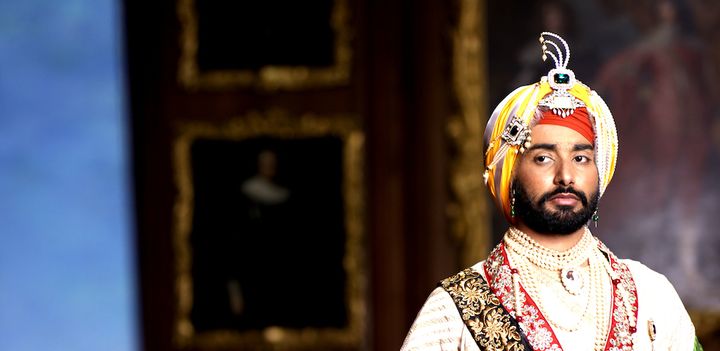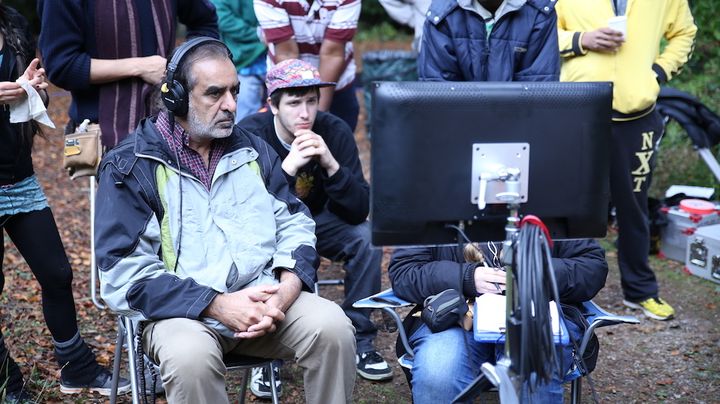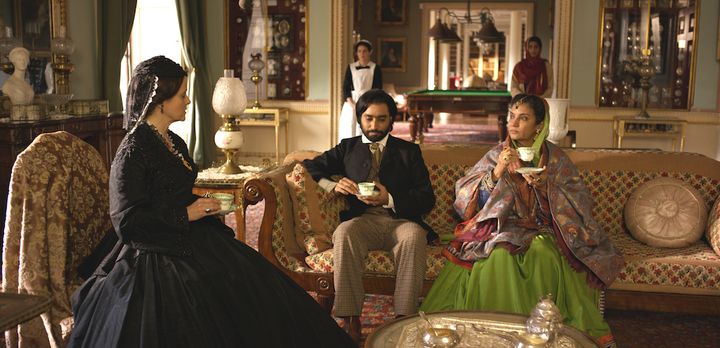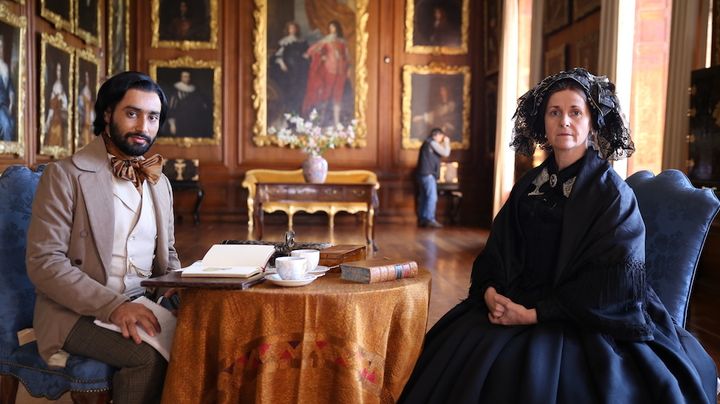
Satinder Sartaaj as The Black Prince
Full of drama, emotion, poignancy—even tragedy, THE BLACK PRINCE, the story of Maharajah Duleep Singh, begins with his birth in 1838, continues with his ascent to the throne of Punjab as his country is violently torn apart by toxic feuds and factions, and unfolds further still as he comes of age in Victorian England. It also offers an illuminating exploration into his close friendship with Queen Victoria herself, godmother to his children. What is remarkable about Kavi Raz’s beautifully rendered film about the life of Duleep Singh (which has already won several film festival awards, including Best Drama Feature at the L.A. Film Awards and the Best Newcomer Award for lead actor Satinder Sartaaj at the London Independent Film Awards) is how powerfully it resonates today. Transcending continents and kingdoms, the film traces the story of Duleep Singh’s quiet mission to reclaim his inheritance and govern his people while confronting the towering might of the British Empire—then the dominant force in the world. It is also the story of one man’s quest to find himself.
But who was THE BLACK PRINCE? “When you read about Maharajah Duleep Singh, you see a lot of fact-based material: that he became a king at the age of five and was separated from his mother at the age of seven,” says director Kavi Raz, who was born in Punjab and raised in England. “But there’s not much that people know about the human being, the psychological make up of this man. In the telling of this story, I wanted to connect with Duleep Singh to ask: What was it like to be isolated after being King of one of the most powerful kingdoms in the world at that time?”

Director Kavi Raz at work
From the start, it was a highly personal journey for Raz himself. He had heard about the story of Duleep Singh as a child and was fully aware that the fabled, exiled king was significant to his culture. Sikh groups in the UK would take bus rides to visit his grave at Elveden Hall in Thetford, the impressive Suffolk estate Duleep had once owned in the heart of the British countryside.
Raz, who made his name as a highly successful character actor in Hollywood, says he was drawn to the project because he had experienced a growing inner yearning to tell meaningful stories about his culture. In what the filmmaker describes as “the luckiest moment of my life,” he met historian Jasjeet Singh, a former champion swimmer and water polo player in India, now living in America. Singh, (the executive producer of THE BLACK PRINCE), had conducted extensive research into the life of Duleep Singh.
Singh discussed with Raz how the life of the Last King of Punjab has been shrouded in mystery, told primarily through the lens of the British who effectively ‘adopted him,’ as one of their own. It was where he lived as a young man, where he settled, married and raised a family, steeped in the country’s privileged aristocracy. “I realized that all the material about Duleep Singh was told from the British point of view: they wrote that he wasn’t honest, that his mother was no good, that he was illegitimate,” says Singh.

The Black Prince Movie Still - Satinder Sartaj with Shabana Azmi
While studying at Punjab University, Singh had discovered a different perspective on the life of the legendary figure when he came across important historical source material authored by the former Punjabi monarch himself. The material also included an extraordinary collection of Duleep’s original letters and paperwork that had been brought to Lahore by his eldest daughter, Bamba. “It was an 800-page book which had been published by the university and contained all of Duleep Singh’s letters. Everything was there.”
Determined to bring Duleep Singh’s story to the attention of the world, Kavi Raz and Jasjeet Singh set about collaborating on THE BLACK PRINCE. Once Raz had completed his script, choosing the right actor for the central character became crucial. There were uncanny similarities between Duleep Singh and musician Satinder Sartaaj, who seemed destined for the role even though he had never acted before.
“People have commented that I bear a strong resemblance to him, in terms of skin color, eyes and height—even mannerisms,” says Sartaaj. “The first thing I told the producers was: ‘I am a non-actor. I am a poet and composer.’ Thankfully, they offered me the role and I gave it my best.” Stepping into the part, says Sartaaj, was a formidable responsibility. “It was a great burden on my shoulders because I was representing my culture—but it is also a very proud moment for me.”
Their star, says Kavi Raz, was a “natural.” “Satinder is very emotional, very intelligent and he brings this raw, childlike sort of energy to the part, which was perfect for the character. Even when Maharajah Duleep Singh was in his latter years, I always thought that there was a great innocence to him, a great vulnerability, and that’s what Sartaaj brought to the role.”
Beautifully acted, with a colorful score from composer George Kallis as well as five original Punjabi songs with lyrics written by Sartaaj and also featuring contemporary tracks by the likes of Talib Kweli, Tisha Campbell-Martin, Ozark Henry, Nelly Furtado and AK Amazing, THE BLACK PRINCE reveals the man behind the legendary, elusive figure.

Satinder Sartaj in Church
Duleep Singh, the son of Maharajah Ranjit Singh, known as the ‘Lion of Punjab,’ was an infant when his father died and his kingdom was annexed by the British Empire. His uncle, Jawahar Singh, was killed in front him. Britain basically took over the kingdom at that point,” says Kavi Raz. Placing the story in historical context, Raz adds that Punjab “was probably the wealthiest kingdom in the world at the time. It also had 100 percent literacy. Unusually, religions in Punjab: Hinduism, Islam, Sikhism and Christianity all co-existed. The kingdom sat in a very peculiar situation,” he continues, “The British to the south controlled most of the Indian subcontinent and Russia was to the north. Punjab was a buffer state in between these two powerhouses.”
Separated from his mother by the British and sent to what is now Uttar Pradesh, Duleep was forced to convert to Christianity. In 1845, at age 15, he was dispatched to Britain. The new film focuses on the bond that developed between the teenager and Queen Victoria (played by Amanda Root), who treated the boy she called ‘the Black Prince’ as one of her own children. “Queen Victoria totally loved Duleep. He was like a family member, going on family vacations with them,” notes Jasjeet Singh. “Maybe it was due to some guilt, who knows?”
“I think she was probably like a surrogate mother,” adds Raz.“ She showered him with love and he was very close to her children.”
Amanda Root (THE IRON LADY), who has a strong interest in India and runs a charity that does considerable work in that country, delivers a highly convincing performance as Queen Victoria. Says Root, “The queen’s relationship with Duleep was complex. He comes into her life as a young boy and you see there’s a tension because he’s so unique and he’s very young and needs her attention. I tried to integrate a sense of somebody who has a real heart and values this boy, but also has the weight of state on her shoulders. I think she had to control her feelings, to be masterful. She certainly had a great capacity to love and that’s what interested me.”
She describes her co-star, Sartaaj, as “Open and observant, with great panache. He was learning on the job, and I think he did remarkable work. He was very natural and that naturalness reflected the character, because he must have been quite gauche, in a new environment, and Satinder too was out of his normal environment.”
In England, the teenager was indeed distanced from his own language, culture and of course his religion. “He wasn’t even allowed to meet with other Sikhs. Instead, he was indoctrinated into British ideology,” says Kavi Raz. “He lived like a king in a way, but it was a very controlled sort of a life.” Charged with taking care of the teenager was Dr. John Login, appointed as his guardian, played by acclaimed British actor Jason Flemyng (LOCK, STOCK AND TWO SMOKING BARRELS, SNATCH, X-MEN: FIRST CLASS). “Jason read the script and was so excited about the role and the British aspect of this story,” says Raz. “He wanted to be part of the project to help convey the great injustice that was done.”

Satinder Sartaj with Amanda Root
One of the interesting aspects of Kavi Raz’s script is his nuanced take on the story. It isn’t black and white and while it is told from Duleep Singh’s perspective, the British are not portrayed as villainous. “I did not want to paint the British as monstrous; they weren’t,” says Raz. “Maharajah Duleep Singh himself told his mother that the British were very good people. It was the times they lived in that dictated how they behaved. They were on a mission to take over the world and saw everything from that perspective, from the point of view of their Christian values. They saw their actions as righteous.”
Shot on location—mostly in England—in some of the country’s most impressive castles, with a few scenes filmed in India, there are strong supporting performances from Keith Duffy, David Essex and Rup Magon. Much of the visually lavish biopic focuses on Duleep Singh’s life in Britain, which by all accounts was decadently luxurious. Reputedly an enormously gregarious and personable man, he married twice and had nine children. His first wife, Bamba, is played by British actress, Sophie Stevens.
As he entered his twenties though, Duleep started to feel a deep sense of unease, coupled with a yearning to be meet the mother he had barely known. “Once he reached maturity, he had this feeling that something was missing,” says Jasjeet Singh.
As we discover in the film, with Queen Victoria and the British Government’s agreement, Duleep travels to India and meets his long-lost mother, Rani Jindan, played by renowned Indian actress Shabana Azmi. “Shabana has so much experience and is very well respected,” says Raz. “So in contrast to Satinder, who was new to acting, she brought all this knowledge with her. I worked at a totally different level with her, even in the same scene, because she would understand things in a different way. It was an amazing experience for me as a director to work with these two people at the same time.”
The two actors connect strongly on screen and depict a complicated relationship between mother and son that was evidently immensely challenging. “He met his mother after fourteen or fifteen long years apart so he didn’t recall her well,” says Sartaaj. “They were very different because by then he was so British, and quite spoiled. He didn’t particularly like her when they met because he couldn’t relate to her.” But the reunion did awaken a new sense of purpose in the young man. “Somehow when he meets his mother, Duleep starts to realize who he is, and the significance of his destiny,” says Sartaaj.

His mother, who eventually joins him in England, explains why it is so important for Duleep to reclaim his inheritance. She also reminds her son that for all intents and purposes, Britain has appropriated not only the considerable assets of Punjab, but the family’s private wealth—including the famous Koh-I-Noor diamond. “The British angle has always been that it was ‘gifted’ to Queen Victoria by Duleep Singh but we believe it was taken,” says Kavi Raz.
“His mother told him, ‘Even if the British confiscate the kingdom’s properties, they have no right to our personal holdings,’” says Jasjeet Singh. “He was, at that time, probably the wealthiest man in the world, owning very valuable salt mines which today are worth 32 billion dollars and are now part of Pakistan.”
After the reunion with his mother, everything shifted for Duleep Singh, who would no longer be satisfied with the life of luxury he had enjoyed. Launching a political campaign within Britain, he embarked on a life-long quest to fight for his rights, which involved repeated attempts to get his case heard in the British Parliament (which fell upon deaf ears), writing letters and campaigning across Europe. He started a movement to restore independence to Punjab that eventually became fractured, infiltrated by spies. He later sought support internationally, in Ireland and within India, also traveling to Russia. As a man, Duleep changed completely. Re-converting to Sikhism, he was instilled with a new sense of purpose and a dedication to a cause that was to have ramifications far beyond his own lifetime.
As the plot unfolds, it becomes clear that Duleep Singh’s mission is fraught with difficulty. In fact—it is doomed. But the sadness depicted in the film doesn’t detract from its inspirational heart. “At the very core of the film,” says Kavi Raz, “is a story of a man trying to find himself, which is as relevant today as it was 150 years ago. Right now, we live in a divisive world filled with religious intolerance. The same level of intolerance existed then. But if we have learned anything throughout history, it is that the oppressed will always come to a point when they will rise against that oppression and their voices will be heard.”

Of huge interest and significance to Punjabi communities in India, America and around the world, the film chronicles a pivotal chapter in Sikh history. And while the story doesn’t have a traditional Hollywood happy ending, the life of Maharajah Duleep Singh is ultimately positive. “Duleep Singh actually died peacefully as a free man, as a Sikh,” says Sartaaj,” adding that his struggle inspired Sikhs to continue the fight for freedom until India regained its independence in 1947, when the Sikh Kingdom was divided into India and Pakistan.

“The subcontinent of India was under British rule for over 200 years, and the move towards independence really took root with Maharajah Duleep Singh raising the voice of his people,” concludes Kavi Raz elaborating on the resonance of the film. “ It was ultimately about India’s independence, about how the British had to be driven entirely out of India. Maharajah Duleep Singh offered hope because he inspired an entire nation to seek freedom,” concludes Raz, “And that should not be forgotten.”
